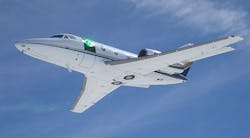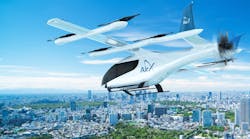The problem involves compensating for atmospheric turbulence to enable a laser weapon to fire accurately from any angle on a fast-moving platform like a supersonic jet fighter.
Without compensating for atmospheric turbulence, a laser weapon mounted to an aircraft moving at near the speed of sound only could fire accurately at targets directly in front of it, company officials say.
Such a setup would be ineffective in countering manned and unmanned aircraft, as well as a variety of missile threats, which can attack from any direction.
Researchers from the Lockheed Martin Space Systems segment in Sunnyvale, Calif., have completed nearly 60 flight tests of the Aero-adaptive Aero-optic Beam Control (ABC) turret, which Lockheed Martin is developing for the U.S. Defense Advanced Research Projects Agency (DARPA) in Arlington, Va.
Related: Lockheed Martin tests laser weapons to protect aircraft from enemy fighters and missiles
The ABC turret is demonstrating a 360-degree field of regard for laser weapon systems on an aircraft flying near the speed of sound, Lockheed Martin officials say. The tests have been on a business jet to simulate the supersonic environment of a jet fighter.
Lockheed Martin began developing the ABC laser turret in early 2013 under terms of a $9.5 million contract modification from DARPA for the ABC program's third phase to improve the performance of high-energy lasers on tactical aircraft against enemy aircraft or missiles in the aft field of regard.
Work on this project is going on at Lockheed Martin facilities in Sunnyvale, Calif.; Fort Worth, Texas; and Orlando, Fla. Work on the third phase of the ABC program is winding up this fall.
The ABC test turret involves a low-power laser that fires through the turret’s optical window to measure and verify the laser's performance in all directions. The design uses aerodynamic and flow-control technology to minimize the effects of turbulence on a laser beam.
The tests have involved a partnership of DARPA, the U.S. Air Force Research Laboratory (AFRL) at Wright-Patterson Air Force Base, Ohio, and the University of Notre Dame in South Bend, Ind.
The ABC turret system is designed to enable high-energy lasers to engage enemy aircraft and missiles above, below, and behind the aircraft. Flow-control and optical-compensation technologies counteract the effects of turbulence caused by the protrusion of a turret from an aircraft's fuselage.
An optical-compensation system that uses deformable mirrors helps the beam to cut through the atmosphere to the target. Without compensation from the deformable mirrors the intense atmospheric turbulence around an aircraft flying at supersonic speeds would scatter the light of the laser beam.
The atmosphere -- even with benign turbulence, can have a profound influence on light. Even on a clear, still night, one can see how the atmosphere influences light by looking at the stars. It's movement in the atmosphere that makes stars appear to twinkle. Stars actually emit fairly continuous beams of light that viewed from space do not twinkle.
Scientists from DARPA and the U.S. Air Force Research Lab will use results of the flight tests to fine-tune future requirements for laser weapons on high-speed aircraft.
Designing high-energy laser weapons for supersonic aircraft has the potential to revolutionize air-to-air and air-to-ground combat. Given a sufficient supply of electric power, laser weapons do not run out of ammunition as conventional cannons and missiles do.
Laser weapons on a rotating turret, moreover, have the potential to be faster, more effective, and far more difficult to spoof than conventional air-to-air weapons. Missiles and bullets fly far more slowly than the speed of light, and are more prone to problems from atmospheric turbulence, high-G forces, and countermeasures to throw off their guidance systems.
Given a 180-degree field of effectiveness for a laser mounted to the surface of an aircraft, just two laser weapons potentially could set up a sphere of protection against missile and aircraft threats.
In addition, laser weapons would be immune to conventional electronic warfare (EW) jamming that can defeat many of even the most advanced radar-guided anti-aircraft missiles. The development of laser weapons would force adversaries to spend time, effort, and money to devise optical countermeasures to laser weapons and usher in a new generation of optical warfare.
It's not clear how long it might take to use the results of these and other tests to devise an effective and deployable laser weapon for high-performance jet fighters. It's unlikely we'll see deployed laser weapons on fighter aircraft until at least the next decade.




